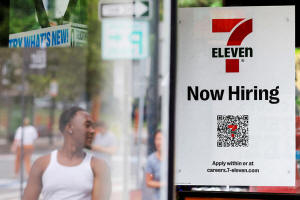US employment, wage growth expected to moderate in June
 Send a link to a friend
Send a link to a friend
 [July 05, 2024] By
Lucia Mutikani [July 05, 2024] By
Lucia Mutikani
WASHINGTON (Reuters) - U.S. job growth likely slowed to a still-healthy
pace in June, with the unemployment rate holding steady at 4%,
increasing the chances that the Federal Reserve will be able to tame
inflation without tipping the economy into recession.
The Labor Department's closely watched employment report on Friday is
also expected to show annual wage growth rising at its slowest rate in
three years. When added to the moderation in prices in May, the report
would confirm that the disinflationary trend was back on track after
inflation surged in the first quarter.
It also could boost Fed policymakers' confidence in the inflation
outlook and push the U.S. central bank a step closer to start cutting
rates later this year.
Financial markets remain optimistic the Fed could start its easing cycle
in September after aggressively tightening monetary policy in 2022 and
2023. Fed Chair Jerome Powell said this week that the economy was back
on a "disinflationary path," but stressed policymakers needed more data
before cutting rates.
"The economy is moving into a reasonable and sustainable, pace of
employment growth," said Brian Bethune, an economics professor at Boston
College. "There's no evidence of any sudden decline, nothing that would
suggest we're suddenly going to tip over. We're still basically tracking
a 'soft landing.'"

Nonfarm payrolls likely increased by 190,000 jobs last month after
surging by 272,000 in May, according to a Reuters survey of economists.
Employment gains have averaged about 230,000 jobs per month over the
past 12 months.
Economists say the economy needs to create at least 150,000 jobs per
month to keep up with growth in the working-age population, accounting
for the recent surge in immigration.
The jobless rate rose to 4.0% in May for the first time since January
2022, boosted by volatile youth unemployment. Some economists expected
it to drop back to 3.9% in June.
A lagging measure of employment, the Quarterly Census of Employment and
Wages (QCEW), has suggested a much slower pace of job growth through the
fourth quarter of 2023 than that of the payrolls data. The QCEW data is
derived from reports by employers to the state unemployment insurance
(UI) programs.
BENCHMARK ESTIMATE
But economists argue the QCEW data does not include undocumented
immigrants, a group that they believe contributed to strong job growth
last year. The Labor Department's Bureau of Labor Statistics will
publish next month its payrolls benchmark estimate for the 12 months
through March of this year.
"Payrolls are on track to be revised downward, but we believe that's not
because payrolls are overcounting but because QCEW is undercounting,"
said Sam Coffin, an economist at Morgan Stanley. "Because QCEW is based
on UI records, it likely misses counting those who are not authorized to
work. If one's not authorized to work, one also is not eligible for
unemployment insurance benefits. In contrast, the payroll survey asks
that employees be counted regardless of legal status."
[to top of second column] |

A 7-Eleven convenience store has a sign in the window reading "Now
Hiring" in Cambridge, Massachusetts, U.S., July 8, 2022.
REUTERS/Brian Snyder/File Photo

Hiring has been largely driven by sectors like healthcare, leisure
and hospitality as well as state and local government education,
which has seen staffing levels head back to pre-pandemic levels.
That trend likely persisted in June, though at a more moderate pace
than in the past months.
Employment in these sectors is mostly back at 2019 levels, and the
525 basis points worth of rate hikes from the Fed since 2022 to curb
inflation has weighed on business formation.
Excess savings accumulated during the COVID-19 pandemic have been
exhausted, contributing to a slowdown in demand for both labor,
goods and services.
"There's been a lot of the catch-up hiring that needed to be done to
get businesses re-staffed again," said Sarah House, a senior
economist at Wells Fargo. "That's largely complete across a lot of
different sectors."
Even as the labor market is cooling, wage growth remains sufficient
to sustain consumer spending and the overall economic expansion.
Average hourly earnings are forecast to have risen 0.3% in June
after climbing 0.4% in May. That would lower the annual increase in
wages to 3.9%, the smallest gain since June 2021, from 4.1% in May.
Wage growth in a 3%-3.5% range is seen as consistent with the Fed's
2% inflation target.
The central bank has maintained its benchmark overnight interest
rate in the current 5.25%-5.50% range since last July. The minutes
of the Fed's June 11-12 meeting, which were published on Wednesday,
showed policymakers acknowledged the economy appeared to be slowing
and that "price pressures were diminishing."
Economists argue the labor market is not driving up inflation,
noting that worker productivity has picked up, and worry that the
Fed could stifle growth by keeping borrowing costs elevated for too
long.

"Wage growth had been high earlier in this expansion, but it's come
down, said Kevin Rinz, a senior fellow at the Washington Center for
Equitable Growth. "Productivity growth has returned to the normal
relationship it has with wage growth such that there's not a huge
gap between those two. It doesn't really seem necessary at this
point to be constraining the labor market for the sake of reducing
inflation."
(Reporting by Lucia Mutikani; Editing by Paul Simao)
[© 2024 Thomson Reuters. All rights
reserved.]
This material may not be published,
broadcast, rewritten or redistributed.
Thompson Reuters is solely responsible for this content. |